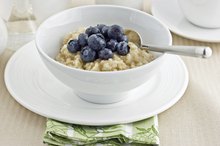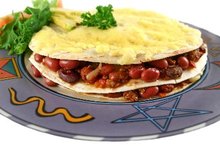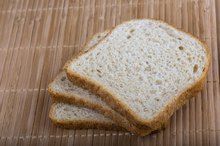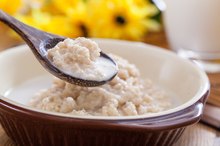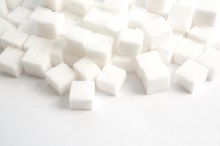What does fact checked mean?
At Healthfully, we strive to deliver objective content that is accurate and up-to-date. Our team periodically reviews articles in order to ensure content quality. The sources cited below consist of evidence from peer-reviewed journals, prominent medical organizations, academic associations, and government data.
The information contained on this site is for informational purposes only, and should not be used as a substitute for the advice of a professional health care provider. Please check with the appropriate physician regarding health questions and concerns. Although we strive to deliver accurate and up-to-date information, no guarantee to that effect is made.
Oats & Carbohydrates
A warm bowl of oatmeal is a dietary staple at many breakfast tables. Oats are a hardy cereal grain cultivated throughout the world and recognized as a delicious food with many health-promoting qualities. According to MayoClinic.com, the soluble fiber present in oats can help reduce levels of low-density lipoprotein, or “bad,” cholesterol 1. Most of the calories in oats are derived from carbohydrates, mainly in the form of starch.
Calories in Oats
One cup of whole-grain oats contains 170 calories. Of these, 20 calories are in the form of fat, equaling 2.5 g. A serving also contains 6 g of protein, or 24 calories. Oatmeal derives the remainder of its calories from carbohydrate. One cup of oats also contains 4 g of dietary fiber, which is calorie-free.
- One cup of whole-grain oats contains 170 calories.
- One cup of oats also contains 4 g of dietary fiber, which is calorie-free.
Carbohydrate Types
Foods Containing Glucose or Fructose
Learn More
Simple carbohydrates are single-sugar molecules such as glucose and fructose. Sucrose is a disaccharide consisting of equal parts glucose and fructose. Polysaccharides are long chains of sugar molecules. Also called complex carbohydrates, they do not have a sweet taste. Starch is a type of complex carbohydrate present in plant foods such as potatoes and beans. Oats are also high in starch.
- Simple carbohydrates are single-sugar molecules such as glucose and fructose.
Carbohydrates in Oats
Of the 34 g of carbohydrates in a serving of oats, 33 g are starch. The remaining 1 g is in the form of sucrose. Your body handles starch and sucrose differently.
Sucrose vs. Starch
Does Old-Fashioned Oatmeal Contain Gluten?
Learn More
Because sucrose is a small molecule, your body easily breaks it down. In your small intestine, the enzyme sucrase breaks down sucrose into glucose and fructose, which are absorbed into your bloodstream for your cells to use as energy. Starch is a larger molecule than sucrose and requires the work of several enzymes, beginning with the enzyme salivary amylase, present in your saliva, and culminating in your small intestine, where additional enzymes finish the job. Because starch takes longer to digest than sucrose, it provides sustained energy levels to keep you satisfied between meals.
- Because sucrose is a small molecule, your body easily breaks it down.
- Starch is a larger molecule than sucrose and requires the work of several enzymes, beginning with the enzyme salivary amylase, present in your saliva, and culminating in your small intestine, where additional enzymes finish the job.
Related Articles
References
- MayoClinic.com: Cholesterol: Top Five Foods to Lower Your Numbers
- "Biochemistry"; Richard A. Harvey, Ph.D.; 2010
- "The Nutrition Doctor's A-to-Z Food Counter"; Ed Blonz, Ph.D.; 1999
- "Natural Health Secrets From Around the World"; Glenn W. Geelhoed, M.D.; 1995
- Carr, T. P., Gropper, S. S., Smith, J. L. (2016). Advanced Nutrition and Human Metabolism. United States: Cengage Learning.
- U.S. Department of Health and Human Services and U.S. Department of Agriculture. 2015–2020 Dietary Guidelines for Americans. 8th Edition. Published December 2015.
Writer Bio
Adam Dave, M.D., has written both fiction and nonfiction since 1997. His most recent work, "The Paradigm Diet," a short course on applied nutrition, is available on Amazon. He holds a medical degree from Medical University of the Americas and trained in family medicine at the University of Colorado.

